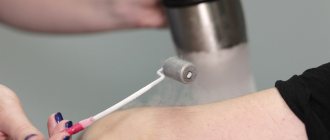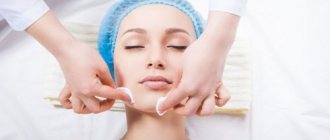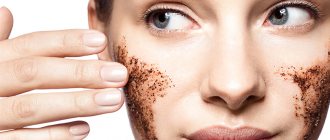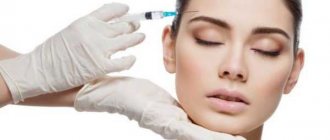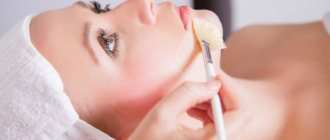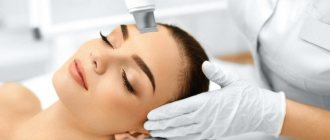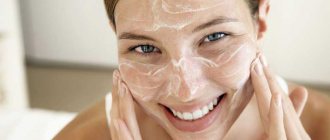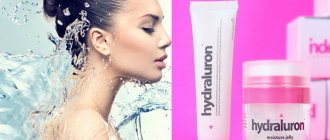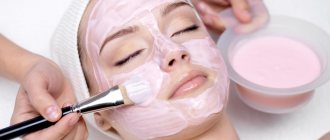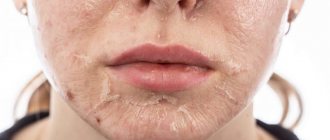With the onset of puberty, the body begins to work in a new way. The hormonal system is also being rebuilt. The sebaceous and sweat glands work more actively. Because of this, pores become clogged much faster than before. An unpleasant shine, acne, and blackheads appear on the skin. To minimize these phenomena during adolescence, the skin needs care. But since the changes have not yet been completed, gentle cleansing is recommended. At this stage, the following cosmetic procedures are suitable for teenagers:
- ultrasonic facial cleansing;
- masks based on natural ingredients;
- light scrubbing.
It is better to use soap- and alcohol-free cleansers to avoid drying out your skin. Cosmetics based on fruit acids have a light exfoliating effect. Various tonics with medicinal herbs have a healing and anti-inflammatory effect. Such care will help remove dead epidermal cells and remove impurities, which will provide renewal, nutrition and hydration.
After 30 years, the skin is already formed. The condition of the skin is affected not only by the internal functioning of the body and atmospheric pollution, but also by stress. Renewal is hampered by the fact that collagen begins to be produced in smaller quantities, and the delivery of nutrients to the deep layers of the dermis worsens due to various blood flow disorders. The skin loses moisture faster, the face becomes less elastic.
At this age, it is possible to use more aggressive types of chemical peeling. Carbon peeling is one such procedure. After it, the face looks significantly fresher and younger, the tone is evened out, and small expression wrinkles are smoothed out.
After 40 years, laser resurfacing and chemical peeling PRX-T33 with a pronounced anti-age effect are recommended.
How often to exfoliate your face
The life cycle from the moment of cell division until the moment when it passes through all the layers of the dermis and becomes part of the upper layers of the epidermis, i.e. surface of the skin is approximately a month. This time is not the exact interval between procedures, since the frequency of peelings is affected, among other things:
- general skin condition;
- the result you want to achieve;
- selected type of peeling;
- age.
If you are concerned about post-acne marks, the full course will range from 3 to 8 sessions. Depending on the procedure you choose, the frequency will vary from 3 days to a monthly visit to the cosmetologist’s office. If you want to remove age spots, you will need a course of 8-10 peeling sessions. At your first visit, the cosmetologist will draw up your personal schedule for procedures.
To understand the methods of cleansing the skin, below are the methods by which you can achieve the desired result.
How to determine if measures are too intense
Knowing how to exfoliate, you will notice that the skin has become elastic and wrinkles have been smoothed out. But a positive result becomes a reason to get too carried away, and as a result, the integument loses its health. In addition, damage from ultraviolet rays increases, sensitivity increases, and premature aging replaces smoothness.
To avoid this prospect, monitor the condition of your skin. Signs of overzealous exfoliation include:
- noticeable dehydration;
- peeling;
- itching;
- redness;
- inflammation;
- rashes and exacerbation of acne.
If you notice these signs, consult a dermatologist, who will recommend a soothing cleanser, complemented by a moisturizing product. In addition, use a cream with SPF filters, and you will soon notice improvements.
Mechanical cleaning
Mechanical peeling affects only the surface of the skin, without affecting the deeper layers of the dermis. Therefore, it can be called a relatively gentle process. After such cleaning, the skin is cleansed of atmospheric pollutants and dead particles of the epidermis, which improves the appearance and helps speed up metabolic processes.
Mechanical skin cleaning includes:
- Brossage - this procedure is performed using a device equipped with soft brushes or sponges. Depending on the goal, it is performed with an interval of 7-1 days.
- Peeling scrubs. Recommendations for the frequency of this type of cleansing depend on the oiliness of the skin. For oily skin – weekly; for dry skin, it is recommended to repeat scrubbing every two weeks. After a course of procedures, which lasts 2 months, a break is necessary to avoid the risk of damage from thinning of the upper layers of the dermis.
- Dermabrasion is skin resurfacing. It is performed using a device with special attachments coated with abrasive particles. Most often used for certain problems that require more serious treatment. For example, scars, old scars, deep wrinkles. Breaks between sessions can last up to 6 months, since the surface layer of the epidermis is removed almost completely
- Microdermabrasion. It is also a type of skin polishing, but the treatment is carried out with attachments containing microcrystals. The number of sessions varies from 5 to 20 sessions, and the break between courses is 1-3 months.
A cosmetologist may recommend alternating procedures, since the effectiveness of one type decreases with each subsequent use.
How to prepare for the procedure?
Before exposing the skin to aggressive acids, it is necessary to prepare it for this. The better the pre-peel care, the less likely you are to get unpleasant side effects. Mechanical cleaning is recommended 2 weeks before the procedure; the use of cleansers is only permissible if they contain weak acids.
Most often it is salicylic or ascorbic acid. Already at this stage it is worth starting to protect your skin from direct sunlight. Be sure to take a break from visiting the solarium or the beach.
If a deep peeling procedure is planned, then a superficial chemical peel of the face is performed 1-2 weeks earlier for preparation. You can learn about post-peeling care by following the link.
What could be the consequences?
You need to be prepared for the fact that your face will look far from ideal immediately after the procedure. The recovery period begins, during which the following may occur:
- Redness, swelling . The skin reaction is similar to an allergy. Antihistamines (decongestants) may help at this stage.
- Peeling of the skin. It can have a different character: from almost imperceptible to the slipping of fibrin films from the skin, which can change color. This peeling is the purpose of peeling. Thus, the epidermis is renewed and gets rid of old cells.
- Tightness, dry skin . Due to the drying effect. A cream will help combat this; it must be prescribed during the recovery period.
Hardware cleaning
Hardware peeling is performed using laser or ultrasound. Suitable for correcting even the most sensitive areas. The procedure itself is less traumatic, so the recovery period does not take much time.
This type of peeling can be used with a break of 3-4 months to maintain the achieved result.
Is anesthesia necessary?
During the procedure, different layers of the skin are injured. This can cause pain or at best discomfort. However, with superficial peeling the sensations are quite tolerable; it is only a slight burning sensation. Therefore, anesthesia is not needed.
Medium peeling is a more serious effect. During the procedure, the discomfort may be stronger, so an analgesic is taken before the procedure.
Deep peeling has an even stronger effect on the skin. It removes the entire top layer (epidermis) and affects the dermis. Therefore, the procedure is more like a surgical operation. It is performed by a plastic surgeon with the help of an anesthesiologist. And in this case general anesthesia is given. But some time ago, gentle formulations for deep effects appeared. With them, an injection of an anesthetic drug is sufficient.
Dry cleaning
The type of chemical peeling depends on the depth of exposure of the composition.
- superficial is made on the basis of fruit acids. To achieve the best result, it is advisable to mix different acids. One session every 3-4 months is enough to maintain the effect.
- Medium peeling is more aggressive than superficial peeling, since high concentration acids are used during the procedure. Due to the deep impact on the layers of the dermis, the effect of the procedure is more noticeable and lasts longer, but the recovery period also increases. It is recommended no more than 3-4 sessions per year.
- deep is the most radical method of chemical action on the deep layers of the epidermis to remove blemishes. After the procedure, the skin is completely renewed. One session is enough for significant results.
But high efficiency comes with high risks. The procedure is not recommended to be carried out at intervals of less than 1 year.
What else you need to know: take into account all the subtleties
How to do peeling at home to get quick results? You will need to consider the following:
- Since the sebaceous glands are active in young people, home treatments sometimes have to be done 3 times a week. But with age, the epidermis becomes thinner, and the frequency decreases to 1-2 exfoliations every 7 days.
- There are no universal recommendations on how to do peeling, so monitor the condition of the skin and its reaction.
- The effectiveness of the procedure does not change whether you perform it in the morning or in the evening. But if you apply retinol products at night, exfoliate before bed: removing dead cells will increase the effectiveness of the treatment.
- Do not use body scrubs as they contain too large cleansing particles. Also, do not apply regular products to the area around the eyes, because special lines have been developed for this area.
Watch a video about how often you can exfoliate your face:
Observe the skin's reaction and develop a treatment that suits you.
Regularity of peeling at home
The intermediate interval between peeling courses can reach three months. The minimum value is 30 days. This is due to the need to give the skin a break from treatment. At home, you can use ready-made products purchased in specialized stores, or hand-prepared analogues. Before you begin peeling, you should consider the characteristics of different skin types:
- if there are no problems with your skin and the condition of the epidermis is normal, you can use a wide range of cosmetics; Among those available at home, one can distinguish a combination in which nuts, salt or coffee are the abrasive, and sour cream is the softening base. A course of such peeling consists of 4 – 8 procedures per month (depending on age);
- dry skin requires more attention to achieve a noticeable effect. It is necessary to carry out at least 6 procedures at intervals of once every 7–10 days. The exact interval is determined by the skin reaction: if irritation occurs, procedures are performed less frequently;
- Finally, natural scrubs (for example, a combination of coffee grounds, sugar and salt) work well on oily skin. The principle of effective peeling for this skin type is intensive exfoliation with a simultaneous moisturizing effect; carried out twice a week;
- combination skin requires peeling less often, and only in the T-zone; 4 sessions per month are enough. Treatment of the entire face is required only when necessary.
In any business (and even more so when it comes to health), it is important to know when to stop. If you, impressed by the first results achieved, decide to increase the frequency of procedures for greater effect, you risk making a serious mistake. Constant exposure to the skin will lead to side effects and complications such as itching, peeling, rash, water imbalance and even inflammation! After such experiments, visiting a doctor will become inevitable.
Features of application
Facial peeling, like other cosmetic procedures, has its own nuances . For example, if you overdo it, people with sensitive skin may experience peeling and rashes. At the same time, the number of affected areas of the face will only increase each time.
It is worth clarifying in advance that when carrying out a procedure with gentle products even three times a week, you can deprive your skin of its health.
This reverse effect is caused by the formation of microcracks in the skin. They release more moisture than necessary. This leads to inflammation.
The main rule is to carry out procedures carefully . Some people think that the more you rub the skin during exfoliation, the better the effect, but this is not true. Rough torture will only worsen the condition of your skin.
Reference ! Do not apply chemicals immediately after using scrubs for mechanical cleansing. These products are only beneficial individually.
In the cold season, hydroxy acids help remove the layer of dead cells . They also smooth out wrinkles. But in winter, the skin is more vulnerable, so after the procedures it is necessary to apply a protective cream, it prevents too much ultraviolet penetration.
Which type should I choose depending on age?
In order for the procedure to be safe and effective, it is important to comply with the “age limits” for using one or another type of peeling.
- 20–30 years .
At this age, the skin still retains its elasticity on its own, although the first wrinkles are already making themselves felt. But gradually the process of cell renewal slows down, and the time comes to resort to cosmetic procedures. For very young girls, it will be enough to scrub their skin at home. And from the age of 25 you can try glycolic peeling, which belongs to the superficial category. Its action is aimed at eliminating dead skin particles, stimulating the activity of collagen-producing cells, and also combating the first expression lines. - 30–40 years .
Age when the elasticity of the skin decreases, and collagen and elastin, which ensure the firmness of the oval, are produced in insufficient quantities. The activity of the sebaceous glands also decreases, and the skin becomes prone to dryness. Especially noticeable are the wrinkles around the eyes and the nasolabial fold. The optimal type of peeling for this age would be a retinoic (or yellow) peeling, consisting of several acids that enhance each other’s effects and eliminate facial wrinkles. The procedure requires recovery from two to seven days, after which the skin will feel comfortable. - 40–50 years .
This age period is characterized by a significant decrease in connective tissue - the dermis, which is why even small wrinkles and folds, as well as age spots, become especially noticeable. The skin renews itself very slowly, and circles and capillary stacks appear around the eyes. Laser peeling will help eliminate the signs of aging, acting as a resurfacing that removes the upper layers of the skin, making it completely renewed. The rehabilitation period will take an average of 10 days, but the effect will become noticeable only after 3-6 months. - From 50 and older . Age-related changes are merciless: the oval loses its contour, the cheeks and chin sag, the eyebrow line noticeably decreases. Radical measures will help correct the situation, namely phenol peeling. This procedure is quite traumatic and requires anesthesia, but it is very effective. Rehabilitation takes more than a week, and the effect lasts for several years.
Important! Phenol is a toxic substance, an incorrectly calculated dose of which can be fatal. Before the procedure, you must carefully study the contraindications, consult with your doctor, and be sure to find a competent cosmetologist who will select the right dosage.
Peeling with calcium chloride
Skin cells are subject to natural death. Their accumulation gives the face an unaesthetic appearance. Its relief becomes uneven, the color fades, and the pores become dirty. The benefit of peeling with calcium chloride is to remove dead cells to solve cosmetic problems. During the procedure, microcracks form on the face. A healing cream will help avoid harm.
Peeling is safe in the absence of contraindications:
- Couperose;
- Delicacies of the skin;
- Acne;
- Allergies to active ingredients.
During the procedure, the cosmetologist covers the face with cleansing foam and applies a calcium chloride solution on top. During the massage, pellets are formed that superficially cleanse the stratum corneum. They are washed off with water. You can perform this peeling at home. It is important to avoid the area around the eyes and lips. The procedure is effective for hyperkeratosis, comedones and increased sebum production.
Ultrasonic peeling
Ultrasound peeling is effective for cleansing and strengthening tissue. The technique does not injure the skin, so there is no rehabilitation period.
Safety does not exclude contraindications:
- Heart and blood diseases;
- Presence of a pacemaker and implants;
- Skin damage and diseases.
The ultrasonic nozzle loosens the epidermis. Its waves destroy bacteria, dissolve comedones and push impurities out of pores. As a result of heating the subcutaneous tissue, the unevenness of the relief resolves, and blood circulation increases.
How is it harmful, are there any contraindications?
General contraindications for all types of peeling:
- individual intolerance to laser, enzymes, acids;
- pregnancy (including planned);
- lactation period;
- acute herpes virus;
- viral infections, respiratory diseases;
- heat;
- ARVI, acute respiratory infections;
- dark or thin skin;
- the presence of birthmarks in the affected area;
- violation of the integrity of the skin;
- period from March to October.
Cuperosis is a contraindication to all types of peeling, except azelaic and retinoic. If contraindications are detected, the doctor must refuse the patient to undergo the procedure.
Any peelings, despite their obvious benefits, are stressful for the facial skin , since their action is aimed at destroying its surface layer. Cosmetic compositions can be harmful - even cause chemical burns.
The procedure ensures an accelerated start to recovery, the body begins to produce its own collagen and elastin. As a result of natural recovery, a rejuvenation effect is achieved.
But partial destruction of the protective barrier causes an immune reaction of the body, so peelings are not recommended during illnesses (skin, cardiovascular, chronic, oncological diseases).
There is a lot of interesting and useful information about cleansing. For example:
- What is the difference between peeling and scrub?
- Features and types of body exfoliation.
- How can this be done in an exotic way - with fish?
- Gas-liquid option for cleansing the scalp - where and how to do it?
- A convenient and practical product for cleaning leather is a mitten!
Types of peeling by depth of influence
The depth of the peeling effect is determined by the degree of penetration of its components into the tissue.
There are 3 types of skin renewal:
- Superficial;
- Middle;
- Deep.
The advantage of superficial peeling is safety. It does not damage the skin. The procedure helps to cope with dryness and the first signs of aging. After cleansing, pores become smaller and a healthy glow appears.
Superficial renewal is effective for sensitive skin suffering from acne, oiliness or early aging. It is achieved by exposure to fruit acids and scrub. In a medium peel, the epidermal layer of skin is removed. Its renewal begins at the basal level.
The procedure allows you to correct serious cosmetic defects:
- Dark spots;
- Deep wrinkles and creases;
- Age-related tissue ptosis;
- Scar changes.
Medium peeling is carried out with chemical acids, a laser or an abrasive attachment.
Its advantage is enhanced tissue regeneration with a short recovery period. Rehabilitation takes no more than 2 weeks. 1 hour after the procedure, redness and swelling will form on the face. Within a week it looks irritated. Dead tissue begins to peel off. After 7–10 days, new healthy cells form in their place.
Facial peeling, the benefits and harms of which have become the subject of debate among doctors, is called deep peeling and is an analogue of plastic surgery. This effect is explained by the influence of phenol or carbolic acid. The reason for medical criticism was the high toxicity of the substance, but for peeling it is used in minimal quantities.
Deep tissue renewal eliminates age-related changes that occur after 40 years.
The achieved effect lasts up to 10 years:
- Ptosis and jowls disappear;
- Deep wrinkles are smoothed out;
- Hyperpigmentation, moles and benign neoplasms disappear.
Phenol peeling is performed in a hospital. The procedure takes about 48 hours. The full recovery period lasts 6 months.
HORMONAL SURGELS
Another factor that allows one to indiscriminately attribute harm to facial peels is, of course, pregnancy and similar manifestations of hormonal storms. This is why expectant mothers are not among the favorite patients of cosmetologists. Even when the risk to the fetus is completely excluded, the reaction of the female body against the background of the restructuring of all major life systems is much more difficult to predict.
This is also associated with restrictions on exfoliation during the first phase of the menstrual cycle. It is difficult to accurately predict how the endocrine system will behave, plus a decrease in the pain threshold - all this forces dermatologists to insist on postponing procedures to a safer time. That is, if the scheduled peeling session falls at the beginning of your next period, it is better to postpone it for at least 3 days, so that you don’t have to guess what to expect as a result: harm or benefit.
We recommend: JESSNER peeling VS RETINOIC peeling. What to choose?
What is it and what problems can be solved with chemical peeling?
Chemical peeling is a cosmetic procedure that is aimed at removing the top layer of skin using chemicals. The skin exfoliates, to which the body responds with accelerated regeneration, as well as the release of substances that improve the tone and color of the skin.
To some extent, the procedure can be compared to a sunburn, after which the damaged skin is separated from the body in large fragments - during this process, regeneration is also accelerated to renew the epidermis.
Indications: pigmentation; the presence of wrinkles and decreased elasticity; the presence of stretch marks and scars; Rosacea.
Important!
Peeling is powerless against sagging skin.
IGNORING CONTRAINDICATIONS
The first and most obvious contraindication is usually any damage to the integrity of the epidermis. For example, a freshly popped pimple with a purulent core cannot be treated with chemical peeling: a burn will remain in this place, which will take much longer to heal.
Few people think that banal eyebrow hair removal or a light scratch from a beloved kitten’s paw during peeling brings harm rather than benefit, although it is, of course, strange to blame the procedure itself in this case.
In addition, diseases that affect blood clotting, nervous exhaustion and immune disorders can add a fly in the ointment during the session itself and subsequent rehabilitation. The healing of the skin after exfoliation will be much longer in such cases. This is why any peel should begin with allergy tests and thoughtful (rather than formal) research into health restrictions.
We recommend: WHEN TO DO PEELING, and when it’s not the season
Recovery period after peeling. How to care for your skin
According to the recommendations of cosmetologists, facial care after peeling involves:
- Refusal of decorative cosmetics;
- Refusal of the cream until peeling forms on the face;
- Using a healing cream for peeling and irritation;
- Using sunscreen.
During the rehabilitation period, it is important not to injure the skin to prevent scarring.
The harm from facial peeling is negligible if you take proper care of your skin. The benefits in the form of beautiful and healthy skin will become noticeable when the rehabilitation period ends.
